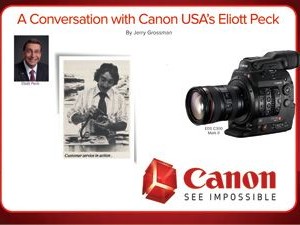
Eliott Peck recently celebrated his 40th anniversary with Canon. In his long history there, he has seen an industry emerge, adapt, grow and evolve. I sat with him to talk about his own career and how Canon sees the future.
JG: Eliott, you’ve been around a while. What’s the secret to survival in this business?
EP: I’ve been very fortunate to have had different roles and responsibilities at Canon—and to have been part of the growth that saw the company become one of the premier brands in the world. We have a long proven history of developing groundbreaking products that have helped define and revitalize our industry through the years. Throughout my tenure at Canon, I’ve been lucky to work with some amazingly bright and supportive people—both American and Japanese.
In 1975, I started in customer service shortly after Canon began direct sales in the U.S. I was the 143rd employee hired. I answered phones, wrote letters, did minor camera repairs and estimates. Following that I became a tech rep, my dream job, and two years later I was asked to become a salesman. Over the years, I took on additional responsibilities as a regional sales manager, national sales manager and vice president of sales.
In 2010, I assumed the role of senior vice president and general manager of sales, overseeing the Imaging Technologies and Communications Group (ITCG), which includes cameras, optics, video, inkjet printers, network video cameras, projectors, and displays. Then this past year, I took on the additional responsibility of chairman and CEO of Canon Information and Technology Services (CITS). CITS encompasses all of the service and support operations that assist consumer, enthusiast and professional end users. It includes our call center in Virginia and our new call center in Albuquerque, New Mexico. So, in some ways, it’s like the circle of life: I went from beginning in Canon’s customer service back to customer service 40 years later.
Are you still involved in sales?
We’re a sales and marketing company, so everyone wears a sales hat in some way. We have evolved and changed our sales organization based on the retail and online market, and Canon direct initiatives, to adapt to how consumers shop. Like any successful company, we’ve had to find new business to add growth and sales opportunities. A prime example is our Cinema EOS business.
Yes, Canon certainly has made its mark in a new category. How did that come about?
This is a great example of leveraging core technologies we already had, such as large image sensors, high-quality optics and fast image processors, and building a new business. Introduced in 2008, the EOS 5D Mark II DSLR was designed primarily to operate as a still camera with additional motion capture functions. However, because of its extraordinary video capabilities in combination with our EF lenses, full-frame image sensor and processor, suddenly we now had a product that was smaller, easier to use, more affordable and allowed aspiring filmmakers to unleash their creativity. This launched us into the market for filmmaking. It truly came about from end-user input and demand.
From there, we met with cinematographers, camera operators and DPs and asked them, if we can build something from scratch, what would you like to have? We dove deep, we listened and what we learned brought us to the launch of the Cinema EOS line just over three years ago. What’s unique for Canon is that this business was born in the U.S. Most of our technologies and product lines were conceived in Japan.
Who is the target for the Cinema EOS line?
Our customers range from world-renowned filmmakers and DPs to the visionary who picks up a video camera for the first time. The largest segment of growth has been in the documentary market—from someone who has a story to tell. It’s exciting to develop products that jump-start and help grow a market—to put the right tools in the hands of those who want to be creative.
We continue to listen to end users to add useful technologies and features to our product line. As an example, at NAB this year we introduced the EOS C300 Mark II digital cinema camera, adding 15 stops of dynamic range to give filmmakers tremendous latitude when shooting very dimly lit scenes to brightly lit ones. It’s really game changing. Another game-changing product is our new Cine-Servo 50–1,000mm 4K ultra-telephoto zoom lens (an $80,000 broadcast and cinema lens), thanks to its exceptional focal range and adaptability. We have a unique edge being able to offer both high-end optics and Cinema EOS cameras.
Let’s talk about the DSLR market; it’s been an interesting time. How does Canon see this market?
We can break the market down into three segments: the entry-level market, Rebel class; the advanced amateur market, the EOS 70D, for example; and the pro market, such as our brand-new EOS 5DS and 5DS R industry-leading 50+ megapixel cameras.
We see an opportunity for growth in each of these segments. Let’s consider that never before have more images been taken, and this fact provides us with a chance to inspire entry-level users to step up to a DSLR. For advanced amateurs who already know what a DSLR can do, video along with still capture is driving new sales. Our professional EOS cameras offer speed, performance and durability, and growth has been very steady. We have also had success leveraging our PIXMA Pro printers for a complete Canon input-to-output solution. This has been a big help for our retail business partners as well.
Do you think the smartphone is a friend or foe to your business?
It’s easy to say foe, but you can also take the positive approach and say friend. Because of smartphones with camera capabilities, you’ve got more photographers today than in any other time in our history. Just looking at the sheer numbers presents our industry with tremendous opportunities. The challenge is how to show them the quality dedicated digital cameras can deliver.
Yes, but it feels like the sharing part hasn’t translated to the non-smartphone.
You’re right. The challenge is in how we as an industry develop high-quality imaging products featuring large image sensors and high-quality optics that also enable easy sharing. We have to improve usability and connectivity. If we can make this process more instantaneous, we have a chance to win and grow.
We also have to change the “good enough” mindset and engage, educate, inspire and demonstrate the benefits of high image quality. Whether it’s a larger image sensor, a better lens or features that allow users to be more creative than they could with a smartphone—that’s a responsibility we take very seriously, and we invest a lot into our educational efforts.
Is it a generational thing? Have we lost the next generation? Do they look at cameras the way they look at the rotary phone—that their parents used it but it’s not for them?
Think about the headphone market. The portable music business went from boom boxes to the Walkman and everything got downsized. Then a few years ago, it became fashionable to have big, stylish headphones again.
I think the younger generation does recognize that DSLRs take better pictures. It’s up to us, the industry, to not just tell the story of usability and high quality but to bring back that cool factor for the product category.
Take VidCon, for example, a show in its sixth year that focuses on the online video culture. What we have found is that the young YouTubers who attend this show are indeed interested in DSLRs. The tools they choose to create their online videos are in many cases not smartphones. Because of this, Canon will be exhibiting at VidCon for the first time this year to educate and demonstrate the capabilities of our DSLRs and EF lenses to this very important younger generation.
Let’s talk about the mirrorless market. Many are surprised that Canon hasn’t been participating.
We do have mirrorless cameras, and they sell quite successfully in other regional markets. In the U.S., it’s not a huge market yet, but perhaps there will be a chance to expand our business.
I would think it would be a lot bigger if Canon were in it.
I think the question is, what satisfies the user’s imaging demands? If the customer is looking to take better photos and have the option to change lenses for increased creativity, it doesn’t matter if it’s mirrorless or a DSLR. We just have to satisfy the need and deliver the experience.
That doesn’t mean we won’t get into that product category more seriously. The key is how we can expand demand and the market size for interchangeable-lens cameras.
In a way, you’ve given your competitors a gift by not getting in. You’ve enabled them to grow a market without Canon.
If you look at our history, there have been other camera categories we were not first to market, APS for example. APS was struggling until the ELPH came along, and suddenly the market expanded. The same holds true for the AE-1, Rebel and Sure Shot. It’s not a matter of technological capabilities.
Point and shoots, are they dead?
No, they are not dead, but the reality is the market has been in a steep decline and we expect this to level off. We focus on areas of the business that are healthy and profitable. On areas where end users can see real value in dedicated digital cameras that have features and functions smartphones don’t have, such as high-sensitivity CMOS image sensors or the power behind a high-quality 65x optical zoom lens. Our direction is very clear. As a business, we have to remain profitable so we can reinvest back into our education, technology, service and support, and our people. We’re firmly committed to those fundamentals.
Point-and-shoot cameras are not going to disappear. But you have to focus on the products where customers see the advantages and benefits—and as a business it must be successful.
What’s your message to photo specialty dealers as to how to change, grow and be successful?
Whether you’re a manufacturer or a retailer, you have to find ways to capture the hearts and minds of customers. Dealers need to show their relevance and value, and engage customers.
I’ll give you an example. My wife was searching for a sewing machine, a Mother’s Day gift. We went into a specialty store and she received an amazingly thorough demonstration of a particular model we had never heard of before. When the demo was over, I asked my wife if she wanted to look around at other stores. She said, “No, I loved what he showed me, the time he spent with me and he promised I could come in as often as I want for lessons.” The experience, education, service and support she received translated into an instant sale.
We want to help dealers in any way we can. Quite frankly, we consider our dealers “business partners,” not customers.
The Canon Expo is coming up—a huge show for Canon every five years. What are your objectives and where is the company going in the next five years?
Canon Expo 2015 is our chance to showcase Canon technology and innovation. In addition, we take this chance to show our business partners, customers, clients and the media product lines, technologies and capabilities they may not be aware of. We expect they will walk away and say, “I didn’t know Canon was this diverse.” Many people know us for our cameras, lenses and business equipment, but this is our World’s Fair of technology and innovation. Some of what we show may be products that are coming for the holiday season or future technologies that may be months or even years away.
What keeps you up at night?
That consumers may not value high-quality imaging products to shoot, file, print and share their lifetime memories. What will happen to all these cherished photos in 10, 20 or 50 years? usa.canon.com





